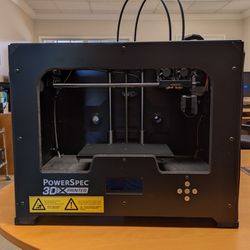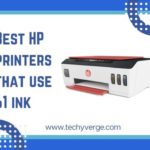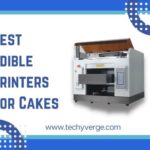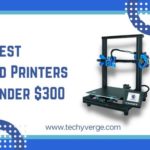The Power Spec Ultra is one of PowerSpec’s flagship 3D printer. Featuring many of the features we’ve come to expect from 3D printers in the sub-$1000 price range, the Ultra is geared toward hobbyists and enthusiasts.
In this article, I will explain Powerspec Ultra 3d printer review and its importance and features as compared to other printers like the tevo black widow 3d printer. So just read till the end.
Lets review
Power Spec Ultra 3D Printer:
This far from perfect, but potentially excellent printer isn’t worth the time of a beginner, but a veteran with a penchant for modding might find it worth their time.
1. Design and features:
The powerspec ultra 3d printer is a cosmetic clone of the Flashforge Creator Pro with its innards mimicking those of the Flashforge Dreamer, so we won’t waste any time getting into it.
These two printers are heavily inspired by the MakerBot Replicator 2. Therefore, there are multiple producers and models of copycat printers.
Apart from the logo, it’s the same 3D printer with the aluminum frame encased in glossed wooden panels on all sides, and acrylic panels on the front hinged door and sides.
In addition to the black color scheme, tidy interior, and off-blue interior lighting, they ensure a stable temperature inside the build chamber.
The PowerSpec Ultra uses additive FDM in a standard XYZ cartesian configuration with NEMA stepper motors running a set of belts and 8mm lead screws.
This printer’s build area measures 229mm x 150mm x 150mm, which is more than enough for most hobbyist modeling and prototyping needs under $1000.
Featuring dual extruders mounted on the same extruder mount, each capable of reaching temperatures up to 230 degrees centigrade, controlled by dual active cooling fans. In theory, the nozzle can achieve resolutions between 100 and 500 microns, with a diameter of 0.4 mm.
Because of the power spec Ultra 3d printer manual, parts, pro2, wanhao, parts, software, i3 mini, and Cura 0.4 mm step length, the extruder setup is only able to measure layer resolutions that are multiples of 0.4 mm.
Essentially, you can print as small as 40 microns, then 80 microns, 120 microns, 160 microns, etc., but not 100 microns or 500 microns as listed in the machine specifications.
A heated aluminum bed covered with polyamide film is capable of 100 degrees centigrade, making it ideal for ABS printing, especially in conjunction with enclosed chambers.
In addition to PLA, ABS, and dissolvable PVA for support structures, the PowerSpec Ultra can handle 1.75 mm diameter filament.
Due to its open-source nature, the system can be used with any type of material. SD card and USB to PC connectivity are welcome additions to the Ultra. There’s a Wi-Fi option on the 2.0 Ultra, but it comes at a price.
2. Assembly:
In addition to the Powerspec ultra 3d printer being a fully assembled 3D printer, it comes packaged in thick bubble wrap between two big styrofoam cutouts, along with the various parts that need to be installed. There’s plenty of room inside the chamber thanks to the configuration of the boxes, and all the parts are easy to remove.
PowerSpec Ultra comes with a power cord, USB cable, sensor line, filament guide tube, spool holder, acrylic sheets (hood, doors, sides), a handle, startup guide, dual extruder heads, 4GB SD card, bolts, hex wrench, and screws.
Despite two empty filament boxes to keep the build plate from moving during transit, the package doesn’t include any filament. We were pleasantly surprised to see the packaging and then realized they were empty.
On the sd card are an installation video and a startup guide. You need a set of silver screws to mount the extruder casing above the build plate, then you attach the acrylic panels. It warped and creaked the acrylic unless we used what felt like an unsatisfactory when fitting the handle.
By inserting the plastic holders into circular mounts and tightening the nuts securing them, the spool holders are fitted to the back panel of the printer. In the back of the printer, there is a guide that connects the filament extruder to the filament spool holders.
For the filament spools onto the holders and plugs in the power cord to complete the setup. In the last step feed the filament through the tubing until the extruder gears latch on the filament and heat the extruder with the display on the printer.
3. Printing:
There was a constant USB connectivity problem with the Ultra before we could even trigger a print. The printer either wasn’t recognized or it didn’t respond, so you had to power down both the printer and PC to try again.
In addition, every power down reset the on-printer display to Chinese language factory settings – a small inconvenience but one that weighs heavy after umpteen restarts.
As soon as the printer connected, PowerPrint crashed. It was underpowered, temperamental, and unresponsive.
We had problems adhering to the first layer no matter what PLA or ABS we used or what extruder/bed temperatures we used, even with hair spray, painter’s tape, and BuildTak. Finally, we replaced the glass bed ourselves and that fixed the adhesion problem.
The bed temperature was adjusted here, the resolution was reduced there, the bed was over-leveled, and the rafts were played with: you name it, we messed with it.
Results were mixed, but when the printer worked properly, they weren’t extraordinary, but well within acceptable limits.
The Powerspec ultra 3d printer suffers from inherent layering issues where the contours are always a little off, possibly because of the distance between the bed and the rods and the bed’s natural wobbling.
4. Support:
This website looks like it was designed in the late 90s doesn’t bode well for Powerspecs aftersales support. Live chat is the only way to get in touch, and our experience was patchy at best. parts and labor are covered for one year.
These ultra owners have sprung up to share their experiences and more importantly the enhancement they made t the printer. With a wealth of knowledge and troubleshooting skills, you can turn the Ultra into a versatile printer.
- Easy to use
- Fast printing
- Very tremendous design
- Difficult to move around
Buying Guide:
- Your budget: There’s no doubt that the power spec ultra 3d printer is expensive, so make sure you can afford it.
- Experience level: You should have some experience with printers before buying the PowerSpec Ultra. Consider an easier-to-use printer if you’re new to 3D printing.
- Your needs: If you need a powerful and versatile printer, the PowerSpec Ultra is a great choice. There are other printers on the market, however, that may be better suited to your needs if you only need a printer for basic tasks.
Frequently Asked Questions:
Micro Center’s power spec ultra 3d printer. Using filament feedstock, it produces thermoplastic parts using fused filament fabrication. There’s a build volume of 229 × 150 × 150 mm9.02 × 5.91 × 5.91 in.
This laser printer delivers high-quality, color laser printing in a small office setting. The HP LaserJet Pro M479fdw is a great choice for high-volume printing thanks to its 50,or-page duty cycle
All precious metals and titanium-based alloys are available in powdered form for 3D printing, as are titanium, steel, stainless steel, aluminum, copper, cobalt chrome, titanium, tungsten, and nickel-based alloys.
Smoother surfaces can be produced by CNC machines than by 3D printers with the right tools. CNC machining is more suitable for parts requiring exceptional smoothness for mating with other precision components than 3D printing.
Final Verdict:
The Powerspec ultra 3d printer is a powerful and versatile 3D printer that can produce high-quality prints. However, it is important to be aware of the potential issues that can occur with this printer before making a purchase.
If you are willing to put in the time and effort to troubleshoot any problems that may arise, the PowerSpec Ultra can be a great printer for you. However, if you are looking for a printer that is more user-friendly and has fewer potential issues, other printers on the market may be a better option for you.
- HP Color LaserJet Pro M283fdw Wireless Laser Printer Review - March 5, 2024
- HP Envy 4520 Wireless All-in-One Color Photo Printer Review - March 5, 2024
- Can Laser Printers Print Color? Affordable Color Laser Printer - February 22, 2024







